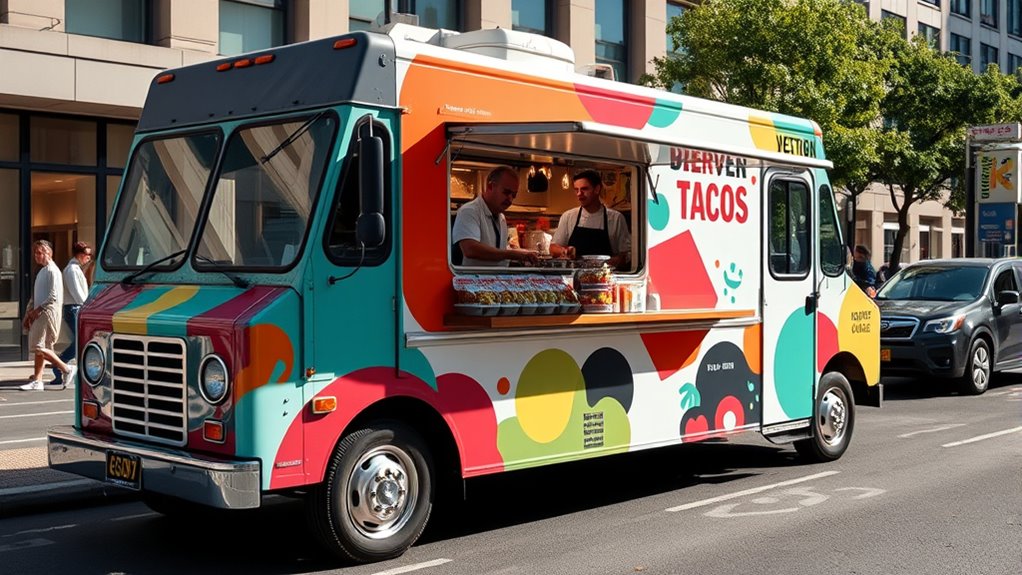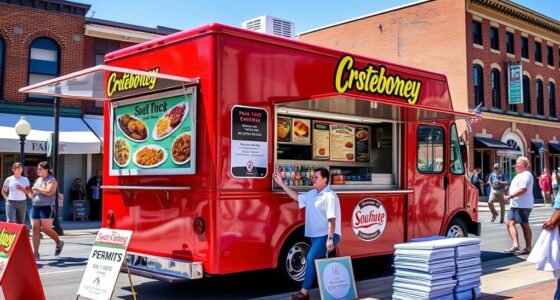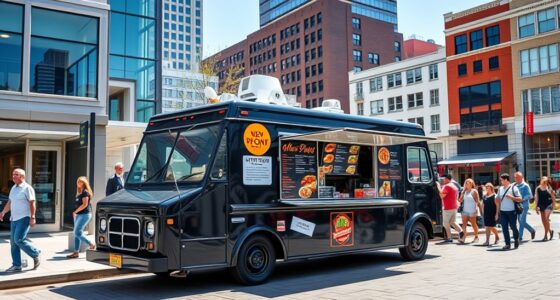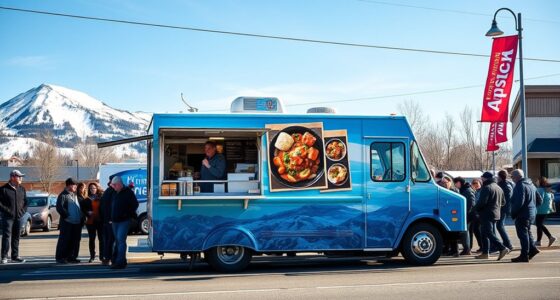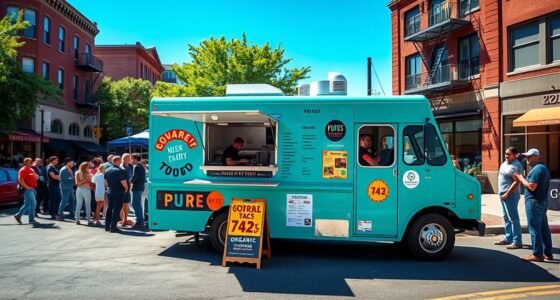To choose the perfect food truck concept, start by analyzing current market trends and what consumers want, like eco-friendly options, plant-based dishes, or cultural cuisines. Identify your target audience and ideal locations, then explore popular food concepts that match their preferences. Consider competition, costs, and the menus you can offer with flexibility. Don’t forget to check permitting and event opportunities. Stay tuned to learn how to refine and test your idea effectively.
Key Takeaways
- Analyze local market demand, consumer preferences, and regional trends to identify popular and underserved food concepts.
- Consider your passion, expertise, and operational capacity to ensure sustainable and authentic menu offerings.
- Evaluate competition and location saturation to select a unique concept that stands out and aligns with target audiences.
- Incorporate flexible menu options and dietary trends like plant-based or specialty diets to attract diverse customers.
- Assess startup costs, equipment needs, and health regulations to choose a feasible concept within your budget and compliance requirements.
Analyze Current Market Trends and Consumer Preferences

To succeed in the competitive food truck market, you need to understand current trends and what consumers really want. Sustainability is a major driver, with 25% higher demand for eco-friendly packaging and plant-based options. Electric trucks cut fuel costs by around 15%, appealing to eco-conscious customers. Digital receipts and waste reduction show your commitment to environmental responsibility, building loyalty. Health trends also shape menus, with 30-40% of consumers seeking vegan, vegetarian, gluten-free, or allergen-conscious dishes. Flavor experimentation, like incorporating ingredients such as ube or pistachio, keeps menus exciting. Technology enhances convenience through AI ordering, mobile apps, and contactless payments. Younger audiences, especially those aged 16 to 34, prioritize quality, diversity, and sustainability, making these trends essential for your success. The market size is substantial, with a valuation of approximately $1.5 trillion, indicating significant opportunities for innovative concepts. Additionally, embracing consumer preferences for personalized and diverse options can further differentiate your food truck in a crowded marketplace.
Identify Your Target Audience and Location Opportunities

Understanding your target audience and choosing the right location are essential steps in establishing a successful food truck business. Knowing that Millennials (ages 25–44) make up the largest segment, you’ll want to focus on convenience, unique flavors, and social media visibility. Younger customers under 24 seek trendy, affordable, late-night options, while older groups appreciate comfort foods and family-friendly offerings. Regions like California and New York City offer high demand, but emerging markets like Portland present growth potential. Focus on urban areas with high foot traffic, nightlife, and cultural diversity. Consider economic factors and proximity to workplaces or campuses to maximize sales. By aligning your menu and marketing with your target demographic and selecting strategic locations, you’ll set a solid foundation for success. Demographic shifts support increased revenue opportunities from older adults, emphasizing the importance of tailoring your offerings to diverse age groups. Additionally, understanding the food truck industry and current trends can help you identify niche markets and stand out from competitors.
Explore Popular and Emerging Food Concepts
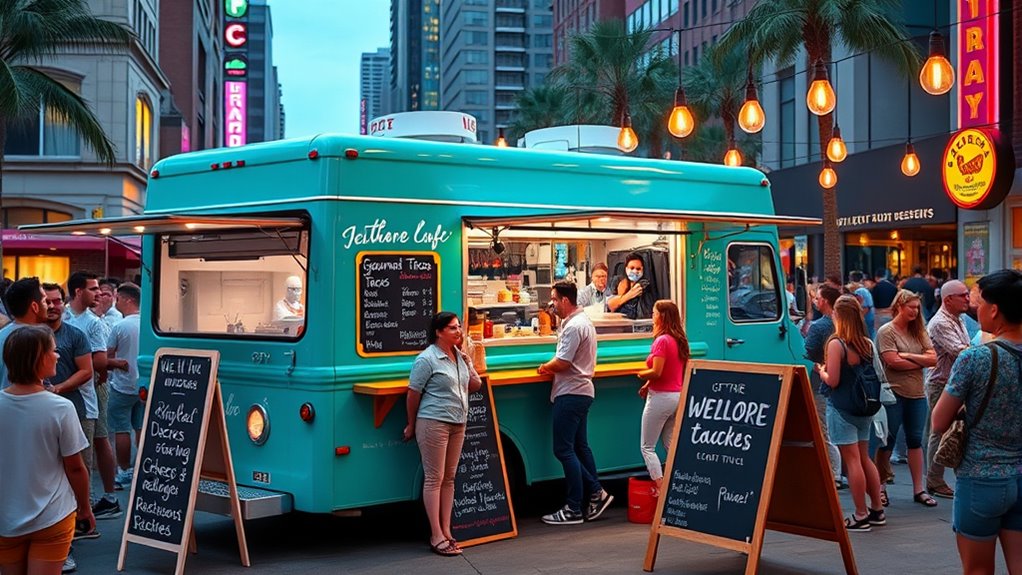
Are you curious about which food concepts are trending and emerging in the mobile dining scene? You’ll find that plant-based and vegan options are gaining popularity, offering lower ingredient costs and appealing to health-conscious, eco-minded customers. Many trucks focus on limited menus with items made from Impossible or Beyond Meat, attracting both vegans and omnivores. Specialty diet-focused concepts like keto, paleo, gluten-free, or allergen-free foods serve underserved niches and build loyal followings willing to pay premiums. Cultural cuisines highlighting regional or international dishes create distinctive brands and high-margin opportunities, especially when emphasizing authenticity and local ingredients. Dessert trucks and specialty beverages, including artisanal ice cream or craft coffee, also thrive with high profit margins and seasonal spikes. Embracing innovative, sustainable, and technology-driven trends keeps your food truck relevant and competitive. Sustainable practices are increasingly being adopted by successful trucks to meet consumer demand and reduce environmental impact. Additionally, incorporating electric-powered vehicles can reduce operational costs and appeal to environmentally conscious customers.
Assess Competition and Market Saturation

With over 35,000 food trucks operating across the US and thousands more in Canada, market saturation is a significant challenge for new entrants. Urban areas experience rapid saturation due to high demand for diverse, convenient food options, making prime locations fiercely competitive. Recognizing regional growth patterns, like California’s booming market, helps you identify areas with less saturation. Analyzing competitors’ menus, pricing, and hours reveals market gaps and opportunities for differentiation. Incorporating trends such as health-conscious or fusion cuisines can set you apart. Leveraging technology for ordering and payments adds a competitive edge. Additionally, monitoring social media and food festivals helps you anticipate market moves. Studying Volkswagen Tuning concepts like engine performance enhancements can inspire innovative ways to optimize your food truck’s operations and efficiency. Carefully evaluating existing density and niche opportunities ensures your concept can thrive without being drowned out by saturation.
Calculate Operational Costs and Budget Constraints
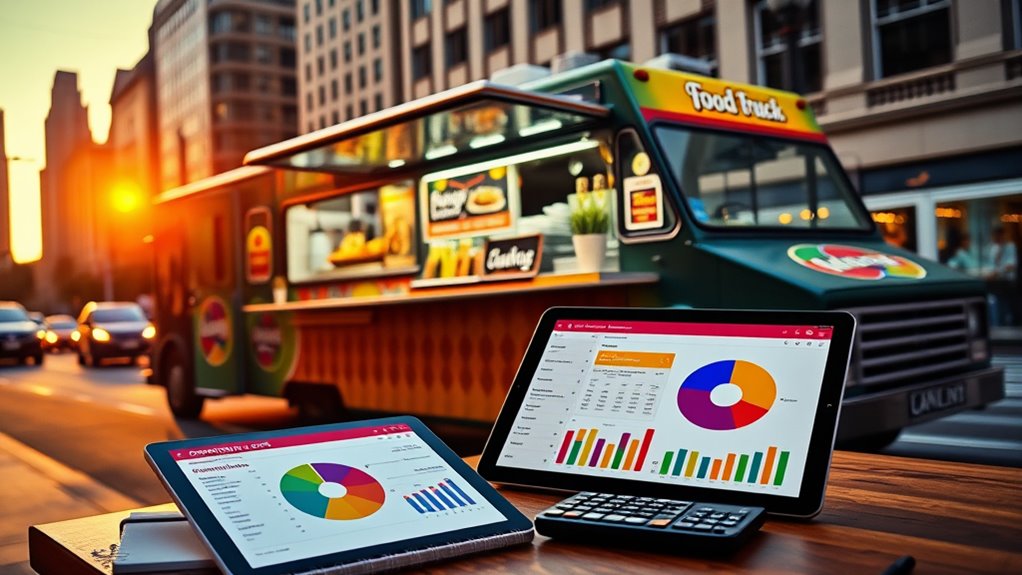
Calculating your operational costs and working within your budget constraints is essential for launching a profitable food truck. Start by estimating fixed costs, like truck purchase—new trucks can cost $50,000 to $175,000, while used ones are $40,000 to $80,000. Don’t forget permits, which can range from $2,000 to $30,000, and monthly expenses like commissary rent ($400–$1,500) and parking ($250–$1,000). Variable costs include ingredients, fuel ($600/month), wages, and maintenance, which can total $3,000–$10,000 monthly. Keep a close eye on these expenses, and balance capital expenses with ongoing costs. Regularly tracking your cash flow guarantees you stay within your budget, helping you identify areas to cut costs and improve profitability. Understanding industry cost estimates is crucial for accurate financial planning and ensuring your business remains sustainable. Additionally, being aware of projector technology features can help you optimize your investment in equipment for presentations or promotional events.
Incorporate Sustainability and Technology Solutions

Incorporating eco-friendly packaging and smart technology can boost your food truck’s efficiency and appeal. Using biodegradable materials and digital tools reduces waste and operational costs while meeting customer expectations. Embracing these solutions positions your business as sustainable and tech-savvy, giving you a competitive edge. Additionally, implementing wall organization systems can help keep your truck tidy and visually appealing, enhancing overall customer experience.
Eco-Friendly Packaging Options
Choosing eco-friendly packaging options for your food truck demonstrates a strong commitment to sustainability and resonates with environmentally conscious customers. You can opt for compostable plates, utensils, and containers made from cornstarch, bamboo, or sugarcane fiber, which break down in industrial composting systems. Biodegradable plastic bags offer strength while naturally degrading, reducing environmental impact. Using takeout boxes and dinnerware made from sustainable fibers maintains food safety with an earthy aesthetic. Paper bags and cardboard meal boxes support recyclability, making waste diversion easier for your customers. Minimizing packaging waste by encouraging reusables, like discounts for reusable containers and refillable bottles, further reduces waste. Clear communication about recycling and composting helps customers participate actively in your sustainability efforts, strengthening your eco-friendly brand identity. Incorporating Preppy Dog Names into your branding, for example, can attract a trendy, sophisticated clientele who appreciate style and eco-consciousness.
Smart Tech Integration Benefits
Smart technology integration offers food trucks a powerful way to boost efficiency, enhance customer experience, and promote sustainability. Mobile POS systems enable you to accept payments anywhere, speeding up transactions and reducing wait times. They also provide real-time sales data that helps you make smarter operational decisions, from adjusting menus to marketing strategies. Mobile POS systems allow for seamless inventory management and integration with payment gateways, further improving operational flow. GPS tracking and route optimization tools identify high-traffic spots, minimize delays, and lower fuel costs, boosting your profitability. Online ordering and delivery integrations expand your reach beyond physical locations, increasing revenue and customer satisfaction. Emerging technologies like AI, automation, and drones can personalize service, streamline operations, and reduce waste. Incorporating sustainable practices into your tech solutions supports a resilient, environmentally friendly business model that adapts to market demands and environmental considerations.
Consider Menu Flexibility and Customization Options

Menu flexibility and customization options are essential for food trucks to stay competitive and meet diverse customer preferences. Offering build-your-own bowls or customizable sides caters to the 55% of consumers seeking allergen-friendly or dietary-flexible options. To maximize appeal, consider:
Menu flexibility and customization attract diverse, health-conscious customers and keep your food truck adaptable to trends and feedback.
- Allowing ingredient swaps or cooking method changes to boost perceived value and encourage add-ons like extra toppings or proteins.
- Testing and updating popular items quickly, as 70% of trucks find their best sellers remain consistent but benefit from menu experimentation.
- Incorporating dietary labels and transparency to attract health-conscious diners and reduce risks, expanding your customer base.
- Implementing Necessary Cookies to ensure the website functions smoothly and provides a seamless user experience for customers researching your menu options.
Flexible menus enable fast adaptation to trends, customer feedback, and seasonal shifts, making your food truck more dynamic and responsive.
Review Regulatory Requirements and Permitting Processes
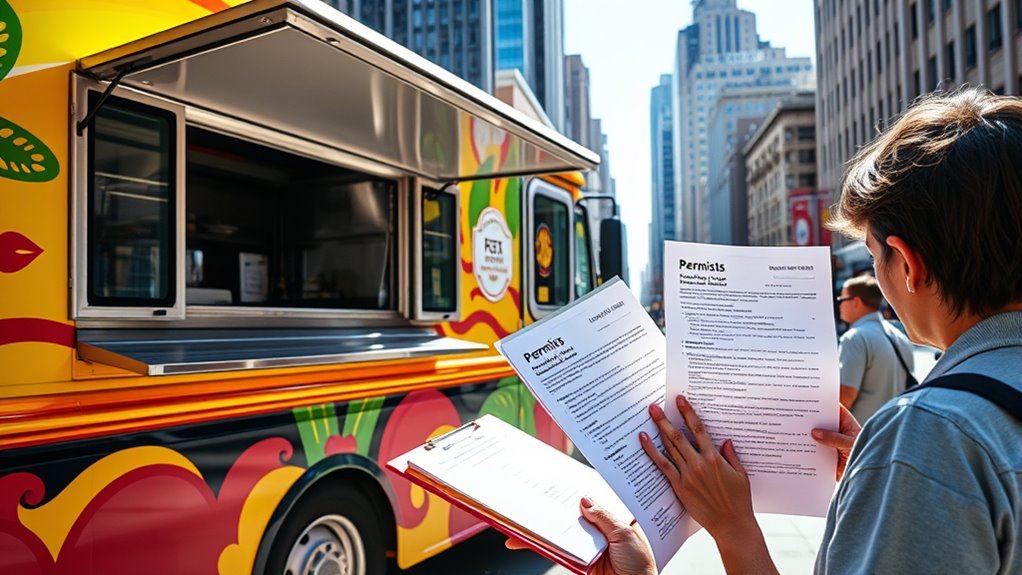
Before finalizing your food truck concept, you need to understand the local licensing regulations and health standards you’ll face. Permitting timelines can vary widely, so planning ahead is crucial to avoid delays. By reviewing these requirements early, you can guarantee your truck complies and operates smoothly from the start. Costs and Licensing are important factors to consider in your planning process to ensure you allocate sufficient budget and meet all necessary legal obligations. Additionally, understanding regulatory requirements related to outdoor and indoor operations can help prevent compliance issues down the line.
Local Licensing Regulations
Finding your way through local licensing regulations is a crucial step in launching your food truck business, as different cities and counties have specific rules you must follow. You’ll need to navigate zoning laws that determine where you can operate, secure parking permits, and possibly obtain temporary event permits for outside zones. Obtain a general business license and register at the state level to operate legally. Here’s what to keep in mind: 1. Zoning & Parking: Confirm permitted zones and secure parking permits to avoid fines or shutdowns. 2. Business Licenses: Obtain a general business license and register at the state level to operate legally. 3. Vehicle & Operational Permits: Pass vehicle inspections and secure registration and parking passes as required. Staying compliant ensures you can focus on serving great food without regulatory setbacks.
Health & Safety Standards
Understanding and adhering to health and safety standards is essential for operating a food truck legally and maintaining customer trust. You must follow strict sanitation practices, such as maintaining proper food temperatures, avoiding cross-contamination, and labeling foods correctly. Regular cleaning of all surfaces, equipment, and prep areas is mandatory. Personal hygiene protocols, including handwashing, glove use, and hair restraints, are enforced. Your truck needs a proper water supply, wastewater tanks, and a three-compartment sink for cleaning utensils. Food must come from approved sources, and storage arrangements should prevent contamination. Routine health inspections check equipment cleanliness, pest control, hygiene, and food handling. Compliance with federal and local regulations is non-negotiable, ensuring your food truck operates safely and within legal boundaries. Regular staff training on safety procedures is also crucial to keep everyone updated on best practices and prevent violations.
Permitting Timelines
Managing the permitting process is a critical step in launching your food truck, and it requires careful planning to ensure timely approval. First, completing your Mobile Food Vendor Permit Application is essential, including submitting supporting documents like business licenses, SCDA permits, and site plans. Second, your application enters an automated review system that provides status updates via email, so stay attentive. Third, scheduling inspections is quick, usually within three business days, depending on staff availability. Keep in mind, permits generally last a year, with renewal applications due at least 30 days before expiration. Delays or missed deadlines can lead to late fees or permit revocation. Planning ahead helps you avoid setbacks and ensures your food truck operates smoothly within all regulatory timelines. Also, some cities may require additional approvals or inspections, so it’s important to verify local requirements early in the process.
Plan for Event Participation and Mobile Catering Opportunities

To effectively plan your food truck’s participation in events and mobile catering opportunities, it’s essential to align your schedule with peak hours and popular event types. Most food trucks see their busiest times between 5–8 PM and 11 AM–2 PM, so focus on these windows to maximize sales. Food festivals, music festivals, farmers markets, and rallies are the top venues, with 58.5% of operators preferring festivals. Be aware that seasonal or event-specific demand can vary, so flexible planning helps. Additionally, understand permit requirements and allow up to 37 days for regulatory approvals. Catering at high-traffic events can boost revenue, but verify your operational setup matches the peak hours and popular locations for ideal success. Peak business hours are mainly from 5 to 8 PM, at 63.6%.
Test and Refine Your Concept Before Launch
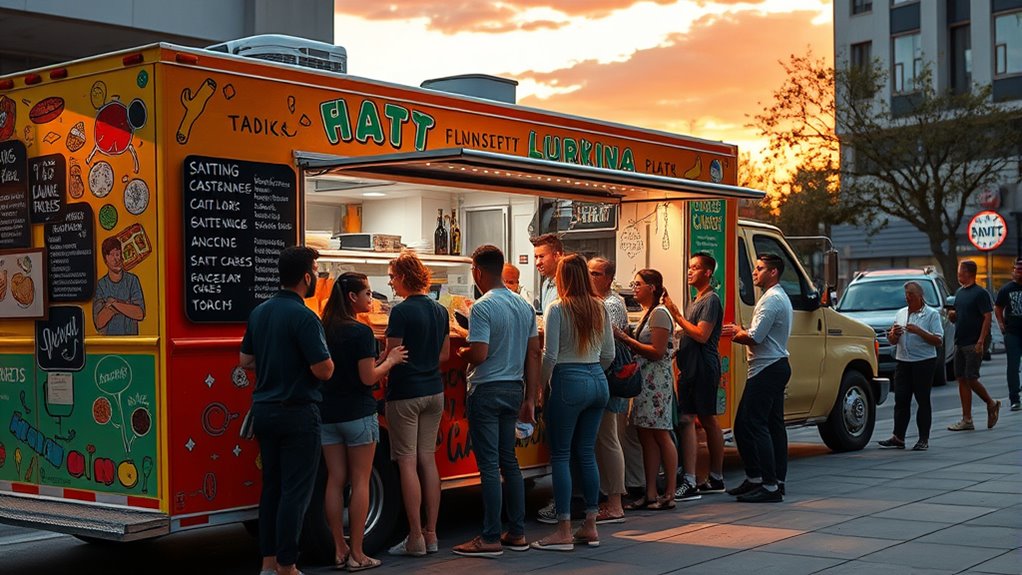
Before launching your food truck, you should test your concept using various market research methods to gather honest feedback. Analyzing customer preferences and operational challenges helps you refine your menu, pricing, and service approach. Small-scale pilot runs and technology tools enable you to make data-driven adjustments, ensuring a smoother opening. Concept testing reveals whether your idea truly addresses a customer need and can guide your development process effectively.
Market Testing Strategies
Testing and refining your food truck concept is essential to guarantee it resonates with your target audience and stands out in a competitive market. To do this effectively, consider these strategies:
- Conduct surveys and interviews with potential customers to gather direct feedback on menu ideas, service styles, and overall appeal.
- Use observation at food trucks and events to identify popular items and customer preferences in real-world settings.
- Launch small-scale pilot tests, such as limited-time menus or pop-up setups, to collect data on sales, customer reactions, and operational efficiency.
- Market testing helps identify customer preferences early, reducing the risk of investing in an ineffective concept. These approaches help you understand what works, uncover unmet needs, and fine-tune your concept before committing fully. By testing early, you boost your chances of success once you launch.
Menu Refinement Techniques
Refining your menu through targeted techniques is essential for ensuring your food truck offers dishes that resonate with customers and operate efficiently. Start by analyzing sales data to identify best-sellers and low performers, then adjust your offerings accordingly. Use customer preferences and trend insights, like local demand for vegan options, to tweak your menu. Incorporate technology such as digital QR codes and mobile ordering platforms to gather real-time feedback and monitor sales patterns. Conduct small tastings and focus groups to refine recipes and presentation, ensuring quality and consistency. Price items competitively by evaluating local market rates and profit margins, and test different price points during soft launches. Regularly collect customer feedback to make continuous improvements, keeping your menu fresh, appealing, and profitable.
Operational Trial Runs
Have you considered how operational trial runs can make or break your food truck’s success? These tests are vital for refining your concept before launch. First, conduct test runs in different settings to mimic real customer flow and uncover operational challenges. Second, evaluate cooking efficiency, service speed, and layout during peak hours to identify bottlenecks. Third, gather feedback on wait times, customer satisfaction, and order accuracy to fine-tune staff roles and workflow. Trial runs also help verify health and safety compliance, test equipment performance, and assess logistics like parking and route planning. By simulating actual conditions, you can adjust staffing, inventory, and procedures—setting a solid foundation for a smooth, successful launch. Understanding the food truck industry’s growth and customer preferences can further inform adjustments and improvements during these trial phases.
Frequently Asked Questions
How Can I Effectively Differentiate My Food Truck in a Crowded Market?
You might worry about standing out among many food trucks, but it’s totally doable. Focus on creating a unique brand identity by offering innovative, flavorful fusion dishes or specialty desserts that catch the eye. Leverage social media to tell your story and connect with local communities. Collaborate with other businesses and participate in events to boost visibility. Consistent branding, excellent customer service, and staying true to your niche will set you apart.
What Innovative Menu Ideas Resonate With Current Consumer Health Trends?
You want menu ideas that align with current health trends, so focus on offering plant-based options like vegan bowls, burgers, and wraps that appeal to health-conscious customers. Incorporate nutrient-dense superfoods such as kale and quinoa, and emphasize fresh, seasonal ingredients. Highlight functional foods like kombucha or cold brew coffee. Share stories behind authentic ethnic dishes, and promote sustainability efforts. These strategies help you connect deeply with health-focused consumers and stand out.
How Do I Balance Sustainability Initiatives With Operational Cost Savings?
Balancing budget-friendly and green goals begins with smart sourcing, saving on costs while supporting local, organic ingredients. Switch to solar-powered systems and energy-efficient equipment to slash expenses and emissions. Use reusable, eco-friendly packaging and implement waste reduction strategies to minimize costs and waste. Leverage technology like digital menus and demand forecasting to streamline sales, save money, and sustain sustainability efforts—all while satisfying eco-conscious customers and elevating your food truck’s reputation.
Which Technologies Are Most Cost-Effective for Small Food Truck Businesses?
You should focus on cost-effective technologies that boost efficiency and reduce expenses. Mobile POS systems like Toast streamline order taking and payments, cutting down manual errors and wait times. Digital menus via QR codes minimize hardware costs, while online ordering platforms attract more customers and reduce staffing needs. GPS route optimization helps you save fuel and time, making these tools essential for small food trucks aiming to grow without overspending.
How Can I Leverage Event Trends to Maximize My Food Truck’S Visibility?
You can leverage event trends by aligning your menu with seasonal and regional themes, boosting relevance and foot traffic. Use geofencing and AI-powered tools to target and serve attendees quickly. Participate in cultural and community events to increase exposure, and promote health-conscious or eco-friendly options to tap into current consumer values. Engaging actively on online communities and gathering positive reviews further amplifies your visibility during high-attendance events.
Conclusion
Choosing the right food truck concept can make or break your success. Did you know that over 60% of food trucks fail within their first year? By analyzing market trends, understanding your target audience, and carefully planning your menu and operations, you set yourself up for growth. Take the time to test and refine your idea—your perfect food truck concept is within reach, and with the right approach, you’ll be serving satisfied customers in no time.
